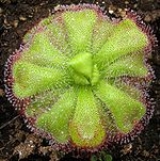
Drosera cuneifolia
Encyclopedia
Drosera cuneifolia is a small rosette
-forming species of perennial
sundew
native to the Cape
in South Africa
. It was first described in 1781.
D. cuneifolia produces green somewhat broad carnivorous
leaves, up to 7 cm (2.8 in) long. D. cuneifolia can become up to 3 cm (1.2 in) in height without the inflorescence
and 15 cm (5.9 in) wide.
In early winter, D. cuneifolia produces multiple (up to 20), small, pink to reddish-purple flower
s at the end of scape
s which can be up to 15 cm (5.9 in) tall. Flowers individually open in the morning and close by mid afternoon, lasting just one day. The flowers can self-pollinate upon closing. The seeds are very small, black, spindle-shaped, and are released from the capsules that form when the flower has died.
During summer in South Africa, D. cuneifolia oversummers. It is found only near the Table mountain complex in South Africa
.
Rosette (botany)
In botany, a rosette is a circular arrangement of leaves, with all the leaves at a single height.Though rosettes usually sit near the soil, their structure is an example of a modified stem.-Function:...
-forming species of perennial
Perennial plant
A perennial plant or simply perennial is a plant that lives for more than two years. The term is often used to differentiate a plant from shorter lived annuals and biennials. The term is sometimes misused by commercial gardeners or horticulturalists to describe only herbaceous perennials...
sundew
Sundew
Drosera, commonly known as the sundews, comprise one of the largest genera of carnivorous plants, with at least 194 species. These members of the family Droseraceae lure, capture, and digest insects using stalked mucilaginous glands covering their leaf surface. The insects are used to supplement...
native to the Cape
Cape of Good Hope
The Cape of Good Hope is a rocky headland on the Atlantic coast of the Cape Peninsula, South Africa.There is a misconception that the Cape of Good Hope is the southern tip of Africa, because it was once believed to be the dividing point between the Atlantic and Indian Oceans. In fact, the...
in South Africa
South Africa
The Republic of South Africa is a country in southern Africa. Located at the southern tip of Africa, it is divided into nine provinces, with of coastline on the Atlantic and Indian oceans...
. It was first described in 1781.
D. cuneifolia produces green somewhat broad carnivorous
Carnivorous plant
Carnivorous plants are plants that derive some or most of their nutrients from trapping and consuming animals or protozoans, typically insects and other arthropods. Carnivorous plants appear adapted to grow in places where the soil is thin or poor in nutrients, especially nitrogen, such as acidic...
leaves, up to 7 cm (2.8 in) long. D. cuneifolia can become up to 3 cm (1.2 in) in height without the inflorescence
Inflorescence
An inflorescence is a group or cluster of flowers arranged on a stem that is composed of a main branch or a complicated arrangement of branches. Strictly, it is the part of the shoot of seed plants where flowers are formed and which is accordingly modified...
and 15 cm (5.9 in) wide.
In early winter, D. cuneifolia produces multiple (up to 20), small, pink to reddish-purple flower
Flower
A flower, sometimes known as a bloom or blossom, is the reproductive structure found in flowering plants . The biological function of a flower is to effect reproduction, usually by providing a mechanism for the union of sperm with eggs...
s at the end of scape
Scape (botany)
In botany, scapes are leafless flowering stems that rise from the ground. Scapes can have a single flower or many flowers, depending on the species....
s which can be up to 15 cm (5.9 in) tall. Flowers individually open in the morning and close by mid afternoon, lasting just one day. The flowers can self-pollinate upon closing. The seeds are very small, black, spindle-shaped, and are released from the capsules that form when the flower has died.
During summer in South Africa, D. cuneifolia oversummers. It is found only near the Table mountain complex in South Africa
South Africa
The Republic of South Africa is a country in southern Africa. Located at the southern tip of Africa, it is divided into nine provinces, with of coastline on the Atlantic and Indian oceans...
.

